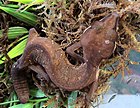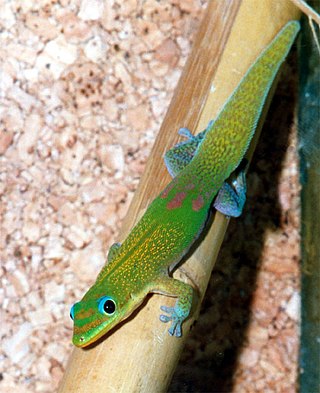
Geckos are small, mostly carnivorous lizards that have a wide distribution, found on every continent except Antarctica. Belonging to the infraorder Gekkota, geckos are found in warm climates throughout the world. They range from 1.6 to 60 centimetres.

Gekkonidae is the largest family of geckos, containing over 950 described species in 62 genera. The Gekkonidae contain many of the most widespread gecko species, including house geckos (Hemidactylus), the tokay gecko (Gekko), day geckos (Phelsuma), the mourning gecko (Lepidodactylus), and dtellas (Gehyra). Gekkonid geckos occur globally and are particularly diverse in tropical areas. Many species of these geckos exhibit an adhering ability to surfaces through van der vaals forces utilizing intermolecular forces between molecules of their setae and molecules of the surface they are on.

Pygopodidae, commonly known as snake-lizards, or flap-footed lizards, are a family of legless lizards with reduced or absent limbs, and are a type of gecko. The 47 species are placed in two subfamilies and eight genera. They have unusually long, slender bodies, giving them a strong resemblance to snakes. Like snakes and most geckos, they have no eyelids, but unlike snakes, they have external ear holes and flat, unforked tongues. They are native to Australia and New Guinea.

Aristelliger is a genus of Caribbean geckos in the family Sphaerodactylidae, commonly known as croaking geckos or Caribbean geckos. The nine named species in the genus are native to various islands in the West Indies, though the species A. georgeensis is also found on mainland Belize. Aristelliger species are nocturnal and mostly arboreal, occupying palm tree trunks and other vertical surfaces. They are among the largest neotropical geckos, with A. lar reaching up to 135 mm in snout-vent-length. They are primarily insectivorous, feeding on a variety of arthropods. Cannibalism of eggs and hatchlings has been reported in A. cochranae. A. lar is omnivorous, and may be an important seed disperser for fruits of the plant Marcgravia. Many species of Aristelliger are accustomed to living among human structures, though several are threatened by urban and agricultural development or invasive species.
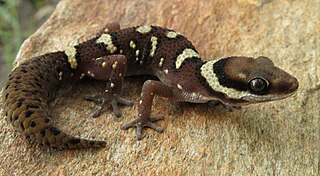
Pachydactylus is a genus of insectivorous geckos, lizards in the family Gekkonidae. The genus is endemic to Africa, and member species are commonly known as thick-toed geckos. The genus also displays rich speciation, having 58 distinct species identified when compared to other closely related gecko genera like Rhoptropus, most of which have emerged since 35Ma. It has been suggested that the reason for this rich speciation not from adaptive radiation nor nonadaptive radiation, but that the genus represents a clade somewhere between the two drivers of speciation. P. bibronii geckos have been used by NASA as animal models for experimentation.

Coleodactylus is a genus of South American geckos.

Matoatoa is a small genus of geckos, lizards in the family Gekkonidae. The genus is endemic to Madagascar.

Ptychozoon was a genus of arboreal geckos, endemic to Southeast Asia, known commonly as flying geckos, gliding geckos, or parachute geckos. They all are now placed in the genus Gekko in the family Gekkonidae. The biogeographic history of the genus Ptychozoon was deeply nested within that of the genus Gekko, the center of diversity of which is within Southeast Asia. Since dispersing into Southeast Asian rainforests, Pytochozoon, like other forest-dwelling vertebrates, adapted to facilitate gliding. All species in the genus Ptychozoon are characterized by cryptic coloration and elaborate webs surrounding the neck, limbs, trunk, and tail. These membranes help to conceal the gecko against trees. When the gecko leaps into the air, the flaps are used to generate lift and allow the gecko to control its fall. It can glide up to 200 feet. Also it does a swoop at the end of its glide to land softly. A similar adaptation is found in geckos of the genus Cosymbotus. There were thirteen described species in the genus Ptychozoon.

Bavayia is a genus of lizards in the family Diplodactylidae. Species in the genus Bavayia are also known commonly as New Caledonian geckos or bavayias. The genus is native to the remote New Caledonia and Loyalty Islands. The 41 species are moderately small to medium-sized geckos, and are distinguished from other genera by their tail length and the shape of their digits.

Eurydactylodes is a small genus of geckos commonly referred to as chameleon geckos from the subfamily Diplodactylidae, endemic to New Caledonia and few adjacent islands. Within the Diplodactylidae, Eurydactylodes resides in the Carphodactylini tribe, and consists of four species. All species share similar morphology as well as lifestyle and habits. The first of the Eurydactylodes species to be classified, E. vieillardi, was discovered in 1869.
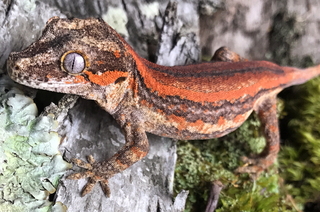
The gargoyle gecko, knob-headed giant gecko, New Caledonia bumpy gecko, or New Caledonian bumpy gecko is a species of gecko found only on the southern end of the island of New Caledonia. Its habitat is threatened by deforestation on the island. This species of gecko is the smallest of the six recognized species in its genus where they often reach about 125 mm in size. This gecko, along with several other Rhacodactylus species are being considered for protective measures by CITES, which would put restrictions on their exportation. This gecko was first described by Bavay in 1869.

The leopard gecko or common leopard gecko is a ground-dwelling gecko native to the rocky dry grassland and desert regions of Afghanistan, Iran, Pakistan, India, and Nepal. The leopard gecko has become a popular pet, and due to extensive captive breeding it is sometimes referred to as the first domesticated species of lizard but no lizards are actually domesticated.

Hemidactylus prashadi, also known commonly as the Bombay leaf-toed gecko or Prashad's gecko, is a species of lizard in the family Gekkonidae. The species is endemic to the Western Ghats of India.

The Phyllodactylidae are a family of geckos (Gekkota) consisting of 163 species in 10 genera, distributed throughout the New World, North Africa, Europe and the Middle East. The family was first delineated based on a molecular phylogenetic analysis in 2008, and all members possess a unique single codon deletion in the phosducin (PDC) gene. The phyllodactylid genus Bogertia has been recently synonymized with Phyllopezus. The name of the family comes from the leaf shaped fingers.

The Carphodactylidae, informally known as the southern padless geckos, are a family of geckos, lizards in the infraorder Gekkota. The family consists of 34 described species in 7 genera, all of which are endemic to Australia. They belong to the superfamily Pygopodoidea, an ancient group of east Gondwanan geckos now only found in Australasia. Despite their well-developed limbs, molecular phylogenies have demonstrated that Carphodactylidae is the sister group to Pygopodidae, a highly specialized family of legless lizards.

The Sphaerodactylidae are a family of geckos (Gekkota) distributed in North America, Central America, South America, and the Caribbean, as well as in Southern Europe, North Africa, the Middle East, and into Central Asia. The family contains 12 living genera and over 200 living species. The family name comes from the ball shape of their finger joints.
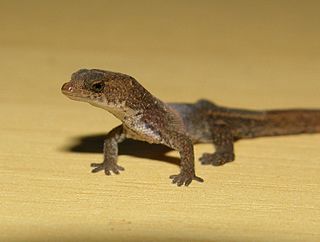
The Brazilian pygmy gecko is a species of South American lizard in the family Sphaerodactylidae. The species is monotypic in the genus Chatogekko. It grows to a maximum total length of only 24 millimetres (0.94 in). It is found in leaf litter on the forest floor, and preys on springtails and mites. The species is oviparous.

The Diplodactylidae are a family in the suborder Gekkota (geckos), with over 150 species in 25 genera. These geckos occur in Australia, New Zealand, and New Caledonia. Diplodactylids are the most ecologically diverse and widespread family of geckos in both Australia and New Caledonia, and are the only family of geckos found in New Zealand. Three diplodactylid genera have recently been split into multiple new genera.

Amalosia is a genus of lizards in the family Diplodactylidae. The genus is endemic to Australia. It includes four species:

Pygopodoidea is a gecko superfamily and the only taxon in the gekkotan subclade Pygopodomorpha. The clade includes three Australasian families: Diplodactylidae, Carphodactylidae, and Pygopodidae. Traditional gekkotan systematics had considered Diplodactylidae and Carphodactylidae as subfamilies of the family Gekkonidae, but recent molecular work have placed Pygopodidae within Gekkonidae making it paraphyletic. These analyses have shown support of Pygopodidae and Carphodactylidae being sister taxa, with Diplodactylidae occupying a basal position in Pygopodoidea.

